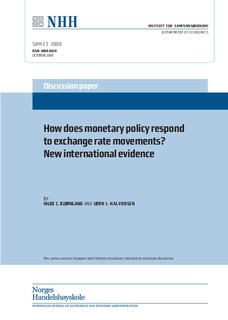| dc.contributor.author | Bjørnland, Hilde Christiane | |
| dc.contributor.author | Halvorsen, Jørn Inge | |
| dc.date.accessioned | 2009-03-25T11:56:39Z | |
| dc.date.available | 2009-03-25T11:56:39Z | |
| dc.date.issued | 2008-10 | |
| dc.identifier.issn | 0804-6824 | |
| dc.identifier.uri | http://hdl.handle.net/11250/163168 | |
| dc.description.abstract | This paper analyzes how monetary policy responds to exchange rate movements in
open economies, paying particular attention to the interaction between monetary policy
and exchange rate movements. We address this issue using a structural VAR model that
is identified using a combination of sign and short-term (zero) restrictions. Our suggested identification scheme allows for a simultaneous reaction between the variables that are observed to respond intraday to news (the interest rate and the exchange rate), but maintains the recursive order for the traditional macroeconomic variables (GDP and inflation). Doing so, we find strong interaction between monetary policy and exchange rate variation: An exchange rate shock that depreciates the exchange rate by one percent increases the interest
rate by 20-40 basis points on impact. Furthermore, a contractionary monetary policy shock that increases the interest rate by 100 basis points appreciates the exchange rate on impact by 2.5-4 percent before it gradually depreciates back to baseline. Our results suggest more theory consistency in the monetary policy responses than what has previously been reported. | en |
| dc.language.iso | eng | en |
| dc.publisher | Norwegian School of Economics and Business Administration. Department of Economics | en |
| dc.relation.ispartofseries | Discussion paper | en |
| dc.relation.ispartofseries | 2008:23 | en |
| dc.subject | exchange rate | en |
| dc.subject | monetary policy | en |
| dc.subject | SVAR | en |
| dc.subject | Bayesian estimation | en |
| dc.subject | sign restrictions | en |
| dc.title | How does monetary policy respond to exchange rate movements? : new international evidence | en |
| dc.type | Working paper | en |
| dc.subject.nsi | VDP::Samfunnsvitenskap: 200::Økonomi: 210::Samfunnsøkonomi: 212 | en |
